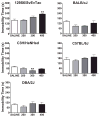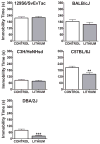Antidepressant-like responses to lithium in genetically diverse mouse strains
- PMID: 21306560
- PMCID: PMC3107888
- DOI: 10.1111/j.1601-183X.2011.00682.x
Antidepressant-like responses to lithium in genetically diverse mouse strains
Abstract
A mood stabilizing and antidepressant response to lithium is only found in a subgroup of patients with bipolar disorder and depression. Identifying strains of mice that manifest differential behavioral responses to lithium may assist in the identification of genomic and other biologic factors that play a role in lithium responsiveness. Mouse strains were tested in the forced swim test (FST), tail suspension test (TST) and open-field test after acute and chronic systemic and intracerebroventricular (ICV) lithium treatments. Serum and brain lithium levels were measured. Three (129S6/SvEvTac, C3H/HeNHsd and C57BL/6J) of the eight inbred strains tested, and one (CD-1) of the three outbred strains, showed an antidepressant-like response in the FST following acute systemic administration of lithium. The three responsive inbred strains, as well as the DBA/2J strain, displayed antidepressant-like responses to lithium in the FST after chronic administration of lithium. However, in the TST, acute lithium resulted in an antidepressant-like effect only in C3H/HeNHsd mice. Only C57BL/6J and DBA/2J showed an antidepressant-like response to lithium in the TST after chronic administration. ICV lithium administration resulted in a similar response profile in BALB/cJ (non-responsive) and C57BL/6J (responsive) strains. Serum and brain lithium concentrations showed that behavioral results were not because of differential pharmacokinetics of lithium in individual strains, suggesting that genetic factors likely regulate these behavioral responses to lithium. Our results indicate that antidepressant-like responses to lithium in tests of antidepressant efficacy varies among genetically diverse mouse strains. These results will assist in identifying genomic factors associated with lithium responsiveness and the mechanisms of lithium action.
© 2011 The Authors. Genes, Brain and Behavior © 2011 Blackwell Publishing Ltd and International Behavioural and Neural Genetics Society.
Figures






References
-
- Alda M, Grof P, Rouleau GA, Turecki G, Young LT. Investigating responders to lithium prophylaxis as a strategy for mapping susceptibility genes for bipolar disorder. Progress in Neuro-Psychopharmacology and Biological Psychiatry. 2005;29:1038–1045. - PubMed
-
- Bai F, Li X, Clay M, Lindstrom T, Skolnick P. Intra- and interstrain differences in models of “behavioral despair”. Pharmacol Biochem Behav. 2001;70:187–192. - PubMed
-
- Bauer M, Adli M, Bschor T, Pilhatsch M, Pfennig A, Sasse J, Schmid R, Lewitzka U. Lithium’s Emerging Role in the Treatment of Refractory Major Depressive Episodes: Augmentation of Antidepressants. Neuropsychobiology. 2010:36–42. - PubMed
Publication types
MeSH terms
Substances
Grants and funding
LinkOut - more resources
Full Text Sources
Other Literature Sources
Medical
Molecular Biology Databases
Miscellaneous

